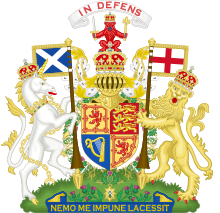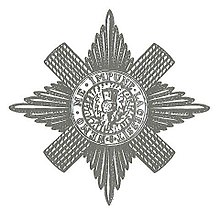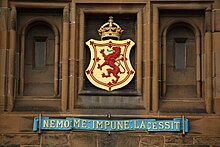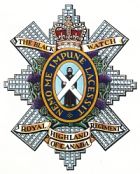
The coat of arms of the United Kingdom are the arms of dominion of the British monarch. They are both the personal arms of the monarch, currently King Charles III, and the arms of the state. In addition to the monarch, the arms are used by state institutions including the Government of the United Kingdom, the Parliament of the United Kingdom, and the British judiciary. Differenced versions of the arms are used by members of the British royal family. The monarch's official flag, the Royal Standard, is the coat of arms in flag form.

Noli me tangere is the Latin version of a phrase spoken, according to John 20:17, by Jesus to Mary Magdalene when she recognized him after His resurrection. The biblical scene has been portrayed in numerous works of Christian art from Late Antiquity to the present. The phrase has also been used in literature, and later in a variation by military units since the late 18th century.

The Most Ancient and Most Noble Order of the Thistle is an order of chivalry associated with Scotland. The current version of the order was founded in 1687 by King James VII of Scotland, who asserted that he was reviving an earlier order. The order consists of the sovereign and sixteen knights and ladies, as well as certain "extra" knights. The sovereign alone grants membership of the order; they are not advised by the government, as occurs with most other orders.

Dieu et mon droit, which means 'God and my right', is the motto of the monarch of the United Kingdom. It appears on a scroll beneath the shield of the version of the coat of arms of the United Kingdom. The motto is said to have first been used by Richard I (1157–1199) as a battle cry and presumed to be a reference to his French ancestry and the concept of the divine right of the monarch to govern. It was adopted as the royal motto of England by King Henry V (1386–1422) with the phrase "and my right" referring to his claim by descent to the French crown.

Honi soit qui mal y pense is a maxim in the Anglo-Norman language, a dialect of Old Norman French spoken by the medieval ruling class in England, meaning "shamed be whoever thinks ill of it", usually translated as "shame on anyone who thinks evil of it". It is the motto of the British chivalric Order of the Garter, the highest of all British knighthoods, except in Scotland.

Thistle is the common name of a group of flowering plants characterised by leaves with sharp prickles on the margins, mostly in the family Asteraceae. Prickles can also occur all over the plant – on the stem and on the flat parts of the leaves. These prickles are an adaptation that protects the plant from being eaten by herbivores. Typically, an involucre with a clasping shape similar to a cup or urn subtends each of a thistle's flower heads. The typically feathery pappus of a ripe thistle flower is known as thistle-down.

The coat of arms of Scotland, colloquially called the Lion Rampant, is the coat of arms historically used as arms of dominion by the monarchs of the Kingdom of Scotland, and later by monarchs of Great Britain and the United Kingdom. The coat of arms, or elements from it, are also used in heraldry to symbolise Scotland in general. The arms consist of a red lion surrounded by a red double border decorated with fleurs-de-lis, all on a gold background. The blazon, or heraldic description, is: Or a lion rampant Gules armed and langued Azure within a double tressure flory-counter-flory of the second.
The Lowland Brigade is a historical unit of the British Army which has been formed a number of times. It is traditionally Scottish as the name derives from the Scottish Lowlands.

Xewkija is an administrative unit of Malta, on the island of Gozo. The population of Xewkija is 3,300 as of March 2014.

A bawbee was a Scottish sixpence. The word means a debased copper coin, valued at six pence Scots, issued from the reign of James V of Scotland to the reign of William II of Scotland. They were hammered until 1677, when they were produced upon screw presses.

The Royal Regiment of Scotland (SCOTS) is the senior and only current Scottish line infantry regiment of the British Army Infantry. It consists of three regular and two reserve battalions, plus an incremental company, each formerly an individual regiment. However, three regular battalions maintain their former regimental pipes and drums to carry on the traditions of their antecedent regiments.

The Scotland women's national rugby union team (Scottish Gaelic Sgioba nàiseanta rugbaidh boireannaich na h-Albarepresents) Represents Scotland in women's international rugby union and is governed by the Scottish Rugby Union. The team competes in the annual Women's Six National Championship and has competed in five of the Women's Rugby World Cups since their hosted debut in 1994. The Nation plays an important role in the rugby world stage.

In my defens God me defend is the motto of both the royal coat of arms of the Kingdom of Scotland and royal coat of arms of the United Kingdom used in Scotland. Contemporary versions of the royal arms show an abbreviated motto, in the form of in defens or, where English is used as an alternative, in defence. The motto appears above the crest of the arms, in the tradition of Scottish heraldry.
Little Jock Elliot is Border ballad of indeterminate age. It is sometimes referred to as the "lost ballad" since the only certain remaining of it is the famous verse "Wha daur meddle wi me ?". A version of it was written by James Smail (1828–1905) under the pseudonym of Matthew Gotterson in The Scotsman, in 1872. He gave it a second part in 1892.
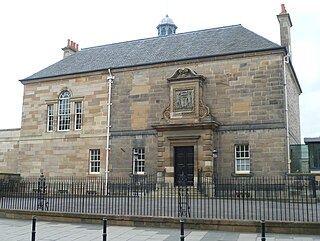
The Archers' Hall is the club house of the Royal Company of Archers, the Sovereign's Bodyguard in Scotland. It is located at 66 Buccleuch Street in the Southside of Edinburgh, and has been used by the company for over 230 years. Building commenced on 15 August 1776, and was completed in 1777 to designs by Alexander Laing. When the foundation stone was laid in 1776, two lines of Latin were inscribed on a plate which was set in the stone. These lines, beginning Nulla Caledoniam, were taken from:
Ecce pharetratos mavortia pectora Scotos,
Hostibus ut fortes tela tremenda ferunt
Nulla Caledoniam gens unquam impune lacesset,
Usque sagittiferis robur et ardor inest
A national coat of arms is a symbol which denotes an independent state in the form of a heraldic achievement. While a national flag is usually used by the population at large and is flown outside and on ships, a national coat of arms is normally considered a symbol of the government or the head of state personally and tends to be used in print, on armorial ware, and as a wall decoration in official buildings. The royal arms of a monarchy, which may be identical to the national arms, are sometimes described as arms of dominion or arms of sovereignty.

The Knights of Cardone were a Medieval order of chivalry. They are noted for their role in the Siege of Negroponte (1470). Under the Venetian command of Admiral Pierre d'Aubusson the Knights of Cardone prepared for battle against Ottoman forces led by Mehmed II. Unfortunately Venetian General Nicolo da Canale lost his nerve and ordered d'Aubusson to retreat which resulted in the loss of Negroponte, and the island of Euboea. Subsequently, during the Siege of Rhodes (1480), d'Aubusson and his Knights successfully defended against another Ottoman attack by Mehmed II.

The Jacobite Royal Scots, sometimes called the Royal-Ecossais, Lord John Drummond's Regiment or French Royal Scots, was a French military regiment made up mostly of Scottish Jacobite exiles. Formed in 1744 under a 1743 order, they are perhaps best known for serving in Scotland during the Jacobite rising of 1745.
The Fifeshire Militia was an auxiliary regiment raised in Fifeshire, Scotland, in 1798. It served in home defence during the Napoleonic Wars and again during the Crimean War when it was converted into an artillery unit as the Fifeshire Artillery Militia. It served in home defence again during the Indian Mutiny and the Second Boer War. It was disbanded in 1909.
The Elizabeth Sword is a ceremonial state sword kept in Edinburgh Castle. It is used on ceremonial occasions in place of the Sword of State, which is part of the Honours of Scotland, that Scottish monarchs used at their coronation. The Elizabeth Sword, along with the Crown of Scotland and the Sceptre, were presented to King Charles III in 2023. The sword, named after Queen Elizabeth II, was commissioned in 2022.
